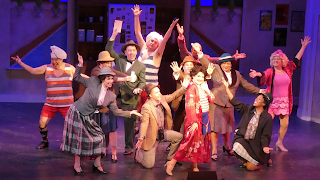A musical that laughs at itself
By Alec Clayton
Published in the Weekly Volcano, March 24, 2019
 |
| The cast of The Drowsy Chaperone, photo by Kat Dollarhide |
Tacoma Musical Playhouse is revising the tongue-in-cheek
musical The Drowsy Chaperone from
their 2010-2011 season with four of the actors from that earlier production: Mauro
Bozzo as Robert Martin, John Miller as Mr. Feldzieg, John B. Cooper as
Aldolpho, Nancy Hebert Bach as Chaperone and TMP Artistic Director Jon Douglas
Rake at Man in the Chair.
With book by Bob Martin and Don McKellar and music and lyrics by Lisa Lambert and Greg Morrison, The Drowsy
Chaperone won five Tony Awards and
seven Drama Desk Awards. And looking
back over my files, I see that I gave it a rousing review in 2011. Now I can’t
imagine why. Adjectives such as clever, entertaining, and sweet certainly apply,
but I can’t now see that it deserved all those awards or the rave review I gave
it. Could be I’ve become less easily pleased after reviewing a play or two a
week for more than 15 years?
Chaperone is a send-up of 1920s musicals and, for that matter, all
musicals. The narrator, billed as simply Man in the Chair, invites the audience
into his apartment where he plays a cast album of a 1920s musical and talks
about it and about musicals in general as the cast reenacts scenes that are
playing on his turntable. The ironic humor resides in the fact that the musical
does everything Man in the Chair makes fun of musicals for doing, and this is
the play’s strongest merit as well as its greatest downfall. The sad thing is it’s
practically impossible to make fun of a bad musical by performing a bad musical
without it being bad, as Rake and company prove in this one — at least in part.
Some of the musical numbers are outstanding, and others are over-the-top
ridiculous, and the same is true for a lot of the comedic bits and for a lot of
the acting.
The first thing Man in the Chair says is that actors should
stay out of the aisles and not break the fourth wall, and then the fourth wall
is shattered in just about every scene, even to the absurd point of having dancers
in a “Chinese” dragon costume swoosh down the aisle.
In the play-within-a-play, it's the day of the wedding of
Robert Martin and Broadway star Janet Van De Graaff (Emma DeLoye). She is going
to give up her career for marriage, which doesn’t sit too well with her
producer, Mr. Feldzieg, who desperately wants to stop the wedding. A couple of
gangsters absurdly disguised as bakers (Sam Barker and Peter Knickerbocker) also
want to stop the wedding, and a ludicrous Latin lover named Aldolpho is hired
to put the kibosh on the wedding by seducing the bride. But he mistakenly seduces
Chaperone — who is willingly seduced.
The silliness is beyond the pale, but is redeemed, somewhat,
by the musical numbers. Besides, Man in the Chair points out that most scenes
in musicals exist only as a means of getting from one musical number to
another.
Rake is outstanding as Man in the Chair. It has been said
that what an actor does when other actors have the stage is a sure indicator of
how good an actor is. Rake’s physical reactions to what the other actors are
doing while he sits and watches are precisely what such a character would do in
such situations. He is so natural in the role you’d think it really is his
story.
Bozzo as the groom-to-be and Josh Wingerter as his best man
are both good actors and singers, and they play off each other well. Their tap
dancing on “Cold Feets” is one of the highlights of the evening.
The best comedy skit is when Aldolpho tries to seduce
Chaperone. This scene starts out with both of them chewing the scenery and then
becomes so much more over the top it is hilarious, the operating principle seemingly
being if you’re going to be silly, be really, really silly.
Bach has the strongest voice of anyone on stage. Her singing
on “As We Stumble Along” is beautiful, as is Deloye’s on “Bride’s Lament.”
The Drowsy Chaperone is lighthearted and lightweight entertainment with a slew of
inside jokes for theater aficionados. Despite Man in the Chair’s admonition
that plays shouldn’t run over two hours, this one runs about two and a half,
including a 15-minute intermission.
No one is listed as director, but Rake is credited as
artistic director and choreographer.
The
Drowsy Chaperone, 7:30 p.m. Friday-Saturday, 3 p.m. Sunday through April 14, 31,
$29 military, senior and students, $22 children 12 and younger, Tacoma


























